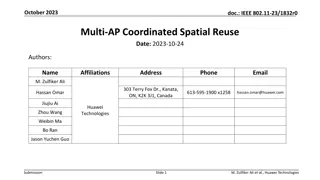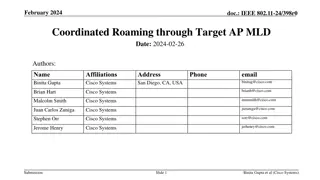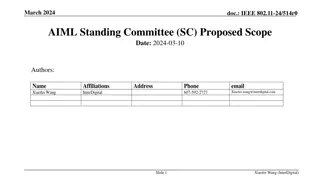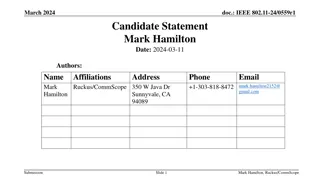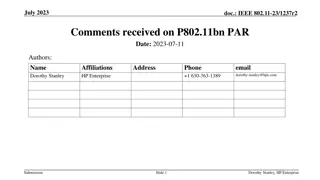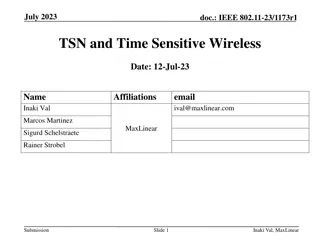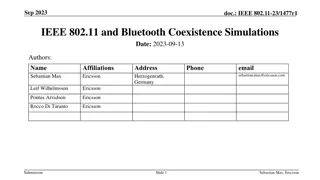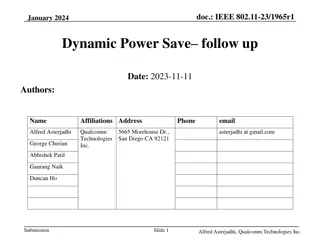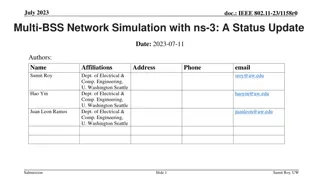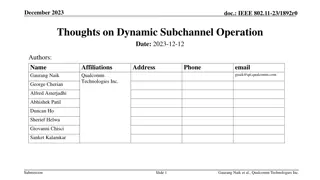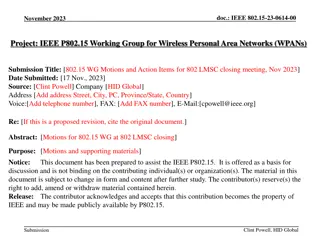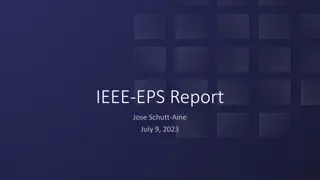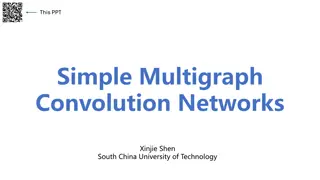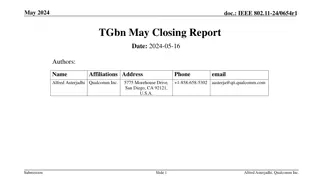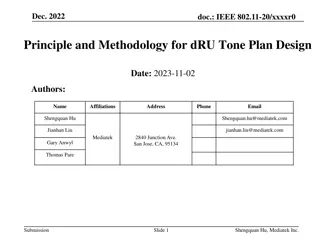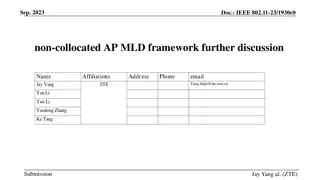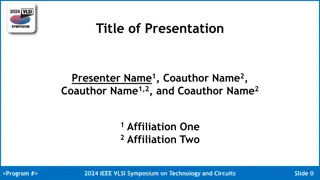Understanding Coordinated Beamforming and MU-MIMO in IEEE 802.11-23/1998r0
This document delves into the intricacies of Coordinated Beamforming (Co-BF) and MU-MIMO techniques in the context of IEEE 802.11-23/1998r0 standard. It explores the concept of nulling in Co-BF, handling more Rx antennas than streams, Zero-Forcing precoding to eliminate Multi-User Interference (MUI), and optimizing spatial streams transmission for multiple antennas. Detailed explanations and diagrams aid in comprehension.
Download Presentation
Please find below an Image/Link to download the presentation.
The content on the website is provided AS IS for your information and personal use only. It may not be sold, licensed, or shared on other websites without obtaining consent from the author. Download presentation by click this link. If you encounter any issues during the download, it is possible that the publisher has removed the file from their server.
Presentation Transcript
November 2023 doc.: IEEE 802.11-23/1998r0 Zero-MUI Coordinated Beamforming Date: 2023-11-09 Authors: Name Doron Ezri Affiliations Address Huawei Phone email Shimi Shilo Huawei Rani Keren Huawei Slide 1 Doron Ezri et al, Huawei
November 2023 doc.: IEEE 802.11-23/1998r0 Introduction Co-BF is one of the Multi-AP cooperation schemes being considered for UHR/TGbn Partial nulling in the context of Co-BF was discussed in [1] In this contribution we discuss nulling in Co-BF in more detail, in particular how to cope with more Rx antennas than the number of streams Slide 2 Doron Ezri et al, Huawei
November 2023 doc.: IEEE 802.11-23/1998r0 MU-MIMO: Basics Let us assume an AP with transmit antennas, and STAs each with a single Rx antenna The simplest solution to eliminate Multi-User Interference (MUI) is Zero- Forcing (ZF) precoding; this means choosing precoder such that (the STAs feedback to the AP): H = + y HWs n D N N W = + Ds n where is a diagonal matrix This may be achieved with the (unit average power) BF matrix 1 H D H D = W 1 F An array of antennas can create nulls N N 1 Slide 3 Doron Ezri et al, Huawei
November 2023 doc.: IEEE 802.11-23/1998r0 MU-MIMO: Multiple Spatial Streams Let us now consider an AP with 6 transmit antennas, and 3 STAs each with 2 Rx antennas, and 2 spatial streams transmitted per STA Now the transmitted signal takes the form = + + x Ws W s W s x 6 1 1 1 2 2 3 3 Data symbols for STA1 Precoder for STA1 and the received signal at the first STA reads = = + y H x H Ws n 1 1 1 + + + H W s H W s n 1 1 1 1 2 2 1 3 3 1 Signal Potential Multi User Interf. Slide 4 Doron Ezri et al, Huawei
November 2023 doc.: IEEE 802.11-23/1998r0 MU-MIMO: Multiple Spatial Streams (cont.) In this case, of course we want (e.g. for ) W 1 = = H W H W 0 0 2 1 * i = H U D V 3 1 i i i or in other words * 2 * 3 H H V 2 = = = W N A N , null null 1 2,3 1 2,3 V 3 which leads to zero MUI and is perfectly aligned with existing SVD based feedback A common solution is the PINV of * 2 * 3 V V Slide 5 Doron Ezri et al, Huawei
November 2023 doc.: IEEE 802.11-23/1998r0 MU-MIMO: Zero MUI with more Antennas than SS Now let s make things more interesting by assuming 3 Rx antennas at each STA, but maintaining 2SS for each one We can extrapolate the previous approach, such that H H 2 = = W N A N , null 1 2,3 1 2,3 3 But this means that the AP must have at least 8 Tx antennas So we did something good (added an Rx antenna) but this leads to a big setback??? Slide 6 Doron Ezri et al, Huawei
November 2023 doc.: IEEE 802.11-23/1998r0 MU-MIMO: Zero MUI with more Antennas than SS (cont.) Let s consider a different approach based on SVD; let us separate the used (first two) singular components from the unused (last component): * 1 * * = = + H U D V U D V 1 1 1 d u v 1 1 1 1 1 1 "Used" " Unus e d " Now we consider a different precoding scheme such that: * 2 * V = = W N A N , null 1 2,3 1 2,3 V 3 which means that we can work with 6 Tx antennas, which is a good starting point Does this approach achieve zero MUI? In the next slides we will evaluate it Slide 7 Doron Ezri et al, Huawei
November 2023 doc.: IEEE 802.11-23/1998r0 MU-MIMO: Zero MUI with more Antennas than SS (cont.) The received signal at STA #1 is ( ) = + + + y H Ws W s W s n 1 1 1 1 2 2 3 3 1 ( )( ) * * = + + + + H Ws U D V 1 1 1 d u v W s W s n 1 1 1 1 1 1 2 2 3 3 1 H 1 But are in the null-space of , so this is where the magic happens: ( ( 1 1 1 2 2 1 1 1 d * 1 V W W , 2 3 )( ) * * = + + + + y H Ws U D 1 1 V 1 1 1 d u v W s W s n 1 1 1 1 1 2 2 3 3 1 ) * = + + + H W s u v W s W 3 3 s n 1 1 u The MUI from all STAs is modulating Slide 8 Doron Ezri et al, Huawei
November 2023 doc.: IEEE 802.11-23/1998r0 MU-MIMO: Zero MUI with more Antennas than SS (cont.) This means that at high SNR, the number of Rx DoFs we need to sacrifice is equal to the rank of the (MU) Interference Covariance matrix (e.g. via MVDR) At high interference-to-noise ratio, this would coincide with So in our case we need to give up a single DoF in order to fully mitigate the MUI from all STAs (which is exactly what we have) Therefore, PINV precoding on -s followed by MVDR/MMSE at Rx lead to zero MUI! * 1 = U y y 1 1 i V Slide 9 Doron Ezri et al, Huawei
November 2023 doc.: IEEE 802.11-23/1998r0 MU-MIMO: Recap & Current Feedback In order to achieve zero MUI in the DL MU-MIMO case, STAs need to feedback the corresponding to the used streams The corresponding (values of the) matrix are also fed-back so the AP can compute power-loading and predict performance (e.g. PPSNR) If the AP wants to transmit fewer streams than the number of columns of the matrix , it can do so freely Using the example in previous slides, if the AP decides to transmit a single stream to the STA, then are in the null space of (the now rank-1) and the magic still happens: ( ( 1 1 1 2 2 1 1 1 s i V D i i V * 1 v W W , 2 3 )( ) * * = + + + + y H w u v U D V W s W s n 1 1 s 1 1 d 1 1 1 1 1 1 2 2 3 3 1 ) * = + + + H w U D V W s W 3 3 s n 1 U The MUI from all STAs is modulating (the now rank-2) but the STA has 2 free DoF so it can remove the MUI in its entirety 1 Slide 10 Doron Ezri et al, Huawei
November 2023 doc.: IEEE 802.11-23/1998r0 Co-BF in TGbn Problem Statement Co-BF is one of the potential AP Cooperation schemes for UHR/TGbn With Co-BF, each AP transmits (in MU-MIMO style) to its STAs, while placing a null on the other AP s STAs This scheme is relatively simple synchronization requirements are mild and no joint precoder computation is required However, in the case of more Rx antennas than streams, the method we discussed earlier collapses What we discussed in previous slides will now apply to each AP separately the MUI would be modulated over one vector for each AP For example, with 2 APs, the MUI would be modulated over 2 vectors, so MVDR (with a single DoF) will fail So adding more Rx antennas will not solve the problem Slide 11 Doron Ezri et al, Huawei
November 2023 doc.: IEEE 802.11-23/1998r0 Co-BF in TGbn Problem Statement (cont.) The total collapse is evident from the figure below We see that when the number of Rx antennas at the STA side is larger than the number of SS, the performance collapses Slide 12 Doron Ezri et al, Huawei
November 2023 doc.: IEEE 802.11-23/1998r0 Co-BF in TGbn Na ve Approach Assume (naively) all APs know all channels AP #1 knows that in order to mitigate the MUI of AP #1, STA #1 will project onto the null-space basis of which is Thus, the interference from AP #2 to STA #1 takes the form ( ) 1,2 3 3 4 4 1 + U H W s W s * 1 u U 1 * The key point here is that if we make sure and are in the null-space of the 2x8 matrix , then we have zero MUI , 1 1 2 U H W W 3 4 * Slide 13 Doron Ezri et al, Huawei
November 2023 doc.: IEEE 802.11-23/1998r0 Co-BF in TGbn Potential (Practical Feedback) Approach Let us consider the following, slightly different process: STA #1 computes the feedback to AP #1 as usual STA #1 knows that in order to mitigate the MUI of AP #1, it will project onto the null-space basis of which is The interference from AP #2 to STA #1 again takes the form ( ) 1,2 3 3 4 4 1 + U H W s W s * 1 u U 1 * And just like in the previous slide, the key point here is that if we make sure and are in the null-space of the 2x8 matrix , then we have zero MUI W W 3 4 * 1 U H 1 2 , Slide 14 Doron Ezri et al, Huawei
November 2023 doc.: IEEE 802.11-23/1998r0 Co-BF in TGbn Potential (Practical Feedback) Approach So specifically for AP #2 we can think about the following: STA #1 computes the SVD of (instead of ) STA #1 feedbacks (the conjugate of) the (2) vectors computed in the previous step (this reuses the existing feedback format) AP #2 computes the precoders as usual (based on the feedback ), such that ( ( 1,2 1 null * 1 H U H 1,2 1 2 , eq 1,2 V eq 1,2 V ) eq* 1,2 W W V , null 3 4 ) * U H But there are more aspects to consider, including transmission of a lower rank (using fewer streams than fed-back); this is discussed in the next slide Slide 15 Doron Ezri et al, Huawei
November 2023 doc.: IEEE 802.11-23/1998r0 Co-BF in TGbn Potential (Practical Feedback) Approach In order to accommodate lower rank and reduce the complexity, we consider the following: STA #1 computes the orthonormal basis of (the row space of) This can be carried out using, for example, QR decomposition or Gram-Schmidt which require lower complexity than an SVD STA #1 feedbacks the (conjugate of) the (2) vectors of the basis of to AP #2, denoted (same format) AP #2 computes the precoders as usual (based on the new feedback), such that ( 3 4 1,2 , null * 1 U H 1 2 , * 1 U H 1 2 , eq 1,2 V ) eq* W W V This approach can be easily extended to 3 or more APs Slide 16 Doron Ezri et al, Huawei
November 2023 doc.: IEEE 802.11-23/1998r0 Co-BF in TGbn Potential (Practical Feedback) Approach The following figure compares the performance between the existing (per-AP/STA) feedback, denoted regular , and the approach described in the previous slides (#13-#16) denoted enhanced It is clear to see how the error floor associated with the existing feedback is solved using this approach Slide 17 Doron Ezri et al, Huawei
November 2023 doc.: IEEE 802.11-23/1998r0 Conclusions We explained how precoding is carried out today in MU-MIMO and how the precoder is designed for more Rx antennas than the number of streams We showed how it is sufficient in MU-MIMO to feedback the singular vectors, and the AP can use any subset of these and still maintain zero MUI This cannot be extended trivially to the case of Co-BF, as explained and shown in simulation results We proposed a potential approach that completely solves this problem and maintains the existing feedback format Slide 18 Doron Ezri et al, Huawei
November 2023 doc.: IEEE 802.11-23/1998r0 References [1] 11-22/0766r1: Performance of C-BF and C-SR (Ron Porat et al) Slide 19 Doron Ezri et al, Huawei
November 2023 doc.: IEEE 802.11-23/1998r0 Appendix MATLAB Code Example % Two APs, each with 8 Tx antennas, and 4 STAs, each with 3 Rx antennas - we create all channels H_11 = 1/sqrt(2)*(randn(3,8)+1i*randn(3,8)); % channel from AP #1 to STA #1 H_12 = 1/sqrt(2)*(randn(3,8)+1i*randn(3,8)); % channel from AP #2 to STA #1 H_21 = 1/sqrt(2)*(randn(3,8)+1i*randn(3,8)); % channel from AP #1 to STA #2 H_22 = 1/sqrt(2)*(randn(3,8)+1i*randn(3,8)); % channel from AP #2 to STA #2 H_31 = 1/sqrt(2)*(randn(3,8)+1i*randn(3,8)); % channel from AP #1 to STA #3 H_32 = 1/sqrt(2)*(randn(3,8)+1i*randn(3,8)); % channel from AP #2 to STA #3 H_41 = 1/sqrt(2)*(randn(3,8)+1i*randn(3,8)); % channel from AP #1 to STA #4 H_42 = 1/sqrt(2)*(randn(3,8)+1i*randn(3,8)); % channel from AP #2 to STA #4 Slide 20 Doron Ezri et al, Huawei
November 2023 doc.: IEEE 802.11-23/1998r0 Appendix MATLAB Code Example (cont.) % Using the traditional/existing method interference alignment doesn t work [U_11,D_11,V_11] = svd(H_11,'econ'); [U_21,D_21,V_21] = svd(H_21,'econ'); [U_31,D_31,V_31] = svd(H_31,'econ'); [U_41,D_41,V_41] = svd(H_41,'econ'); Null_AP1_STA1 = null([V_21(:,1:2)'; V_31(:,1:2)'; V_41(:,1:2)']); % null precoder from AP #1 to STA #1 Null_AP1_STA2 = null([V_11(:,1:2)'; V_31(:,1:2)'; V_41(:,1:2)']); % null precoder from AP #1 to STA #2 W_11 = Null_AP1_STA1*(randn(2,2)+1i*randn(2,2))/sqrt(2); % precoder from AP #1 to STA #1, using random per-STA precoding (in practice would be based on channel) W_21 = Null_AP1_STA2*(randn(2,2)+1i*randn(2,2))/sqrt(2); % precoder from AP #1 to STA #2, using random per-STA precoding (in practice would be based on channel) [U_12,D_12,V_12] = svd(H_12,'econ'); [U_22,D_22,V_22] = svd(H_22,'econ'); [U_32,D_32,V_32] = svd(H_32,'econ'); [U_42,D_42,V_42] = svd(H_42,'econ'); Null_AP2_STA3 = null([V_12(:,1:2)'; V_22(:,1:2)'; V_42(:,1:2)']); % null precoder from AP #2 to STA #3 Null_AP2_STA4 = null([V_12(:,1:2)'; V_22(:,1:2)'; V_32(:,1:2)']); % null precoder from AP #2 to STA #4 W_32 = Null_AP2_STA3*(randn(2,2)+1i*randn(2,2))/sqrt(2); % precoder from AP #2 to STA #3, using random per-STA precoding (in practice would be based on channel) W_42 = Null_AP2_STA4*(randn(2,2)+1i*randn(2,2))/sqrt(2); % precoder from AP #2 to STA #4, using random per-STA precoding (in practice would be based on channel) Interference_at_STA1 = [H_11*W_21, H_12*[W_32 W_42]]; Interference_rank_at_STA1 = rank(Interference_at_STA1,1e-6); % interference rank is 2, not 1! Interference_at_STA2 = [H_21*W_11, H_22*[W_32 W_42]]; Interference_rank_at_STA2 = rank(Interference_at_STA2,1e-6); % interference rank is 2, not 1! Interference_at_STA3 = [H_32*W_42, H_31*[W_11 W_21]]; Interference_rank_at_STA3 = rank(Interference_at_STA1,1e-6); % interference rank is 2, not 1! Interference_at_STA4 = [H_42*W_32, H_41*[W_11 W_21]]; Interference_rank_at_STA4 = rank(Interference_at_STA2,1e-6); % interference rank is 2, not 1! Slide 21 Doron Ezri et al, Huawei
November 2023 doc.: IEEE 802.11-23/1998r0 Appendix MATLAB Code Example (cont.) % Using the suggested method interference alignment now works!! H_12_eq = U_11(:,1:2)'*H_12; [Q,R] = qr(H_12_eq',0); % Gram-Schmidt can be used as well V_12_eq = Q; H_22_eq = U_21(:,1:2)'*H_22; [Q,R] = qr(H_22_eq',0); % Gram-Schmidt can be used as well V_22_eq = Q; Null_AP2_STA3 = null([V_12_eq'; V_22_eq'; V_42(:,1:2)']); % null precoder from AP #2 to STA #3 W_32 = Null_AP2_STA3*(randn(2,2)+1i*randn(2,2))/sqrt(2); % precoder from AP #2 to STA #3, using random per-STA precoding (in practice would be based on channel) Null_AP2_STA4 = null([V_12_eq'; V_22_eq'; V_32(:,1:2)']); % null precoder from AP #2 to STA #4 W_42 = Null_AP2_STA4*(randn(2,2)+1i*randn(2,2))/sqrt(2); % precoder from AP #2 to STA #4, using random per-STA precoding (in practice would be based on channel) Interference_at_STA1 = [H_11*W_21, H_12*[W_32 W_42]]; Interference_rank_at_STA1_new = rank(Interference_at_STA1,1e-6); % interference rank is 1 now! Interference_at_STA2 = [H_21*W_11, H_22*[W_32 W_42]]; Interference_rank_at_STA2_new = rank(Interference_at_STA2,1e-6); % interference rank is 1 now! Slide 22 Doron Ezri et al, Huawei




